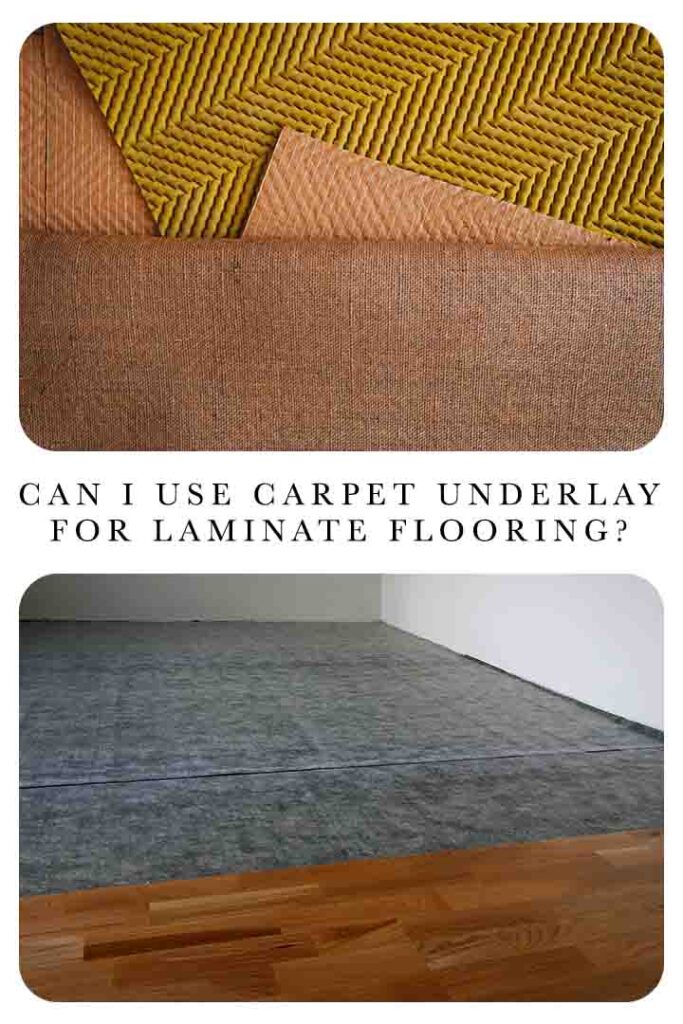Have you ever walked across your laminate floor and felt a slight hollowness underneath your feet? Maybe you’ve heard a creak or two as you move around, reminding you of the hard surface beneath. The desire for a softer, more comfortable feel underfoot is a common one, and many homeowners look to underlay to create a more forgiving and quieter surface. But what about reusing old carpet as a DIY solution? Can you really use carpet as underlay for laminate flooring? Let’s dive into the pros, cons, and considerations of this potentially cost-effective project.

Image: thehappyfloorsite.com
Before we get into the nitty-gritty, it’s important to understand why underlay is crucial for laminate flooring in the first place. Underlay acts as a cushion, absorbing sound and adding a layer of insulation, making your floors more comfortable to walk on. It also helps to even out minor imperfections in the subfloor, ensuring a smooth and stable surface for your laminate planks. So, while you might be tempted to save money by using carpet underneath your laminate floor, there are several factors to consider before making this decision.
Is Carpet a Suitable Underlay? The Pros and Cons
The idea of using old carpet underlay might seem appealing, especially if you have surplus carpet lying around. It’s essentially a layer of cushioning, and you might think it’s a perfect fit for underlay. However, it’s not quite as simple as it seems. Let’s explore the advantages and disadvantages of using carpet:
Pros:
- Cost-effectiveness: If you’re working with a limited budget, reusing old carpet can be a practical and cost-effective way to add underlay without spending extra.
- Softness and Comfort: Carpet inherently offers cushioning, providing improved comfort as you walk across your laminate floor.
- Noise Reduction: Carpet can help absorb some sound, making your floors quieter, especially if you have a hard subfloor.
Cons:
- Moisture Issues: Carpet is known for trapping moisture, and this dampness can lead to warping or buckling in your laminate flooring. This is particularly problematic in areas that see a lot of foot traffic or are prone to spills.
- Mold and Mildew Growth: With trapped moisture and inadequate ventilation, carpet underlay can create a perfect breeding ground for mold and mildew, leading to potential health issues and compromising the integrity of your flooring.
- Dust and Allergens: Carpet naturally gathers dust, dirt, and allergens, and this buildup can affect the air quality in your home.
- Unevenness: Carpet can compress under the weight of your laminate floor, creating uneven spots that could create a noticeable dip or wobble in your floor.
- Thickness: Carpet can be too thick for some laminate flooring installations.
Alternatives to Carpet: Underlay Options for Laminate Flooring
While the temptation of using old carpet underlay is understandable, it’s crucial to prioritize the longevity and health of your floor. Several other underlay options are specifically designed for laminate flooring, offering superior performance and peace of mind.
- Foam Underlay: Foam underlay is commonly found in stores and offers excellent cushioning and noise reduction. It’s moisture-resistant and provides a level surface for your laminate flooring.
- Cork Underlay: Cork underlay is gaining popularity due to its sustainable nature and impressive acoustic properties. It’s a natural insulator, providing warmth underfoot and adding a layer of comfort.
- Rubber Underlay: Rubber underlay is known for its exceptional durability and noise absorption. It’s a great choice for areas with high foot traffic.
Finding the Right Underlay: Essential Considerations
Choosing the right underlay depends on several factors:
- Room Usage: Consider the level of foot traffic in the room where you’re installing the laminate flooring. For areas with high traffic, choose a durable and resilient option like rubber underlay.
- Moisture Levels: If your room is prone to moisture, choose an underlay with moisture-resistant properties. Foam underlay is an excellent option for this scenario.
- Noise Control: For maximized sound reduction, look for a thick underlay or a specialized acoustic underlay product.
- Insulation: If you want to improve the thermal insulation of your floor, consider cork or foam underlay, which are known for their insulation properties.
Conclusion: Making an Informed Decision
While the allure of repurposing old carpet might seem tempting, especially for budget-conscious homeowners, prioritizing the long-term health and integrity of your laminate flooring is essential. Using carpet as underlay can lead to moisture issues, mold growth, and unevenness, compromising your flooring and potentially costing you more in the long run. Investing in a specialized underlay designed for laminate flooring provides superior protection, comfort, and peace of mind, ensuring your floor remains in top condition for years to come. Now that you have a deeper understanding of the risks and benefits, consider your individual needs and choose the best option to create a floor you can truly enjoy.

Image: www.stkittsvilla.com
Can I Use Carpet As Underlay For Laminate Flooring






